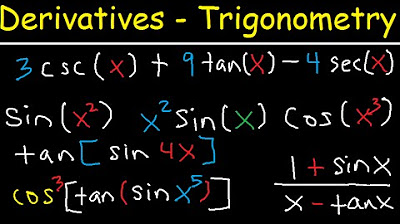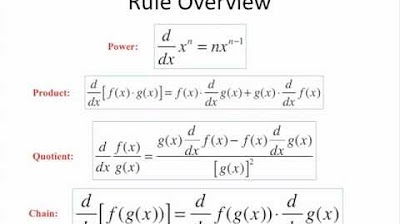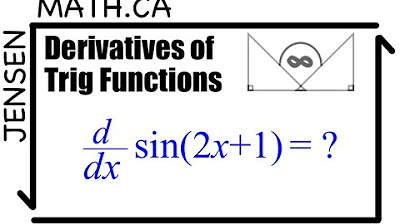CALCULUS 1: DERIVATIVES
TLDRThis educational video offers a comprehensive guide to understanding derivatives in calculus. It breaks down the process of differentiation step by step, starting with basic functions and progressing to more complex expressions involving exponents and polynomials. The host explains the power rule, the constant rule, and the product and quotient rules, demonstrating how to apply these principles to find the derivative of various functions. The video is designed to help viewers grasp the fundamental concepts of calculus and improve their problem-solving skills in this area.
Takeaways
- 📚 The video is an educational tutorial on derivatives, focusing on how to find the derivative of a function.
- 🔍 The first example provided is the derivative of a polynomial function, y = 4 + 2x - 3x^2 - 5x^3 - 8x^4 + 9x^5.
- 📘 The power rule for derivatives is introduced, which states that the derivative of x^n with respect to x is n * x^(n-1).
- 📝 The constant rule is highlighted, noting that the derivative of a constant is zero, as constants do not change.
- 🔢 The process of differentiating involves applying the power rule to each term of the polynomial, simplifying the result.
- 🔄 The chain rule is mentioned for functions raised to a power, involving differentiating the base function and applying the power.
- 📈 The product rule is explained for the derivative of a product of two functions, which involves two terms: the derivative of the first function times the second, and the first function times the derivative of the second.
- 📉 The quotient rule is introduced for the derivative of a quotient of two functions, which is a bit more complex and involves four terms.
- ✍️ The script provides step-by-step differentiation of several functions, demonstrating the application of the rules mentioned.
- 📚 The importance of practicing the power rule and other derivative rules is emphasized for automatic differentiation.
- 👍 The video encourages viewers to share the tutorial with others who might benefit from the information.
Q & A
What is the main topic of the video?
-The main topic of the video is derivatives, specifically how to find the derivative of a function and the proper methods for solving derivatives.
What is the first problem presented in the video?
-The first problem involves differentiating the function y = 4 + 2x - 3x^2 - 5x^3 - 8x^4 + 9x^5.
What is the significance of the constant term in the derivative of a function?
-The constant term in the derivative of a function is significant because the derivative of a constant is always zero, as constants do not change.
What is the power rule for differentiation?
-The power rule for differentiation states that the derivative of x raised to the power of n with respect to x is n times x to the power of n-1.
What is the derivative of 2x with respect to x?
-The derivative of 2x with respect to x is 2, as the derivative of a variable multiplied by a constant is just the constant.
How is the chain rule applied in the video?
-The chain rule is applied when differentiating a function that is raised to a power, such as (t^2 - 3)^4, by differentiating the inside function and then multiplying by the derivative of the outside function.
What is the product rule for differentiation?
-The product rule for differentiation states that the derivative of a product of two functions, u and v, is the derivative of u times v plus u times the derivative of v.
What is the quotient rule for differentiation?
-The quotient rule for differentiation states that the derivative of a quotient of two functions, u over v, is the derivative of the numerator times the denominator minus the numerator times the derivative of the denominator, all divided by the square of the denominator.
How does the video simplify the expression for the derivative of y = (x^2 + 4)^2 * (x^3 + 2)^3?
-The video simplifies the expression by applying the product rule and then combining like terms to get the final simplified derivative.
What is the final problem presented in the video, and what rule is used to solve it?
-The final problem involves differentiating y = (3 - 2x) / (3 + 2x), and the quotient rule is used to solve it.
Outlines
📚 Introduction to Derivatives and Basic Differentiation
This paragraph introduces the concept of derivatives, explaining how to find the derivative of a function and the correct methods for solving derivatives. The script begins with a problem involving the differentiation of a polynomial function, emphasizing the notation and the process of finding the derivative, denoted as y' or f'(x). It explains the constant rule, where the derivative of a constant is zero, and the power rule, which states that the derivative of x^n with respect to x is n*x^(n-1). The paragraph also demonstrates the application of these rules to the given polynomial function.
🔍 Applying the Power Rule and Chain Rule for Differentiation
The second paragraph continues the discussion on differentiation by applying the power rule and introducing the chain rule for functions raised to a power. It explains how to differentiate a function that includes an expression inside parentheses, using the chain rule formula. The example given involves differentiating a function of the form s = (t^2 - 3)^4, where the chain rule is applied by differentiating the inside function and then multiplying by the derivative of the outside function, all raised to the power of the exponent.
📘 Using Product Rule for Multiplication of Functions
This paragraph delves into the product rule for differentiating the product of two functions. It explains the formula for the product rule and applies it to the function y = (x^2 + 4)^2 * (x^3 + 2)^3. The process involves differentiating each part of the product separately and then combining the results according to the product rule. The explanation includes copying one function and differentiating the other, and vice versa, before simplifying the expression to find y'.
📉 Differentiating Using the Quotient Rule
The final paragraph addresses the differentiation of a quotient of two functions using the quotient rule. It outlines the quotient rule formula and applies it to the function y = (3 - 2x) / (3 + 2x). The process involves differentiating the numerator and the denominator separately and then combining them as per the quotient rule, which includes subtracting the product of the denominator and the derivative of the numerator from the product of the numerator and the derivative of the denominator, all divided by the square of the denominator. The paragraph concludes with simplifying the expression to obtain y'.
Mindmap
Keywords
💡Derivative
💡Differentiate
💡Constant
💡Power Rule
💡Exponent
💡Linear
💡Coefficient
💡Chain Rule
💡Product Rule
💡Quotient Rule
Highlights
Introduction to the concept of derivatives and how to find them.
Explanation of the derivative as the study of the rate of change.
Derivative of a constant is zero due to no change in rate.
Power rule for derivatives: derivative of x^n is n*x^(n-1).
Differentiation of a function with multiple terms, including constants and variables raised to various powers.
Application of the power rule to differentiate polynomial functions.
Differentiation of a function with a constant coefficient multiplied by a variable.
Use of the chain rule for functions within parentheses raised to a power.
Differentiation of composite functions using the chain rule.
Introduction of the product rule for differentiating the product of two functions.
Application of the product rule to differentiate a function that is a product of two expressions.
Differentiation of a function involving a quotient using the quotient rule.
Explanation of the quotient rule and its application to a function with a numerator and denominator.
Simplification of the derivative expression after applying the quotient rule.
Encouragement to practice the power rule and other differentiation techniques for automatic application.
Invitation to share the video with others who might benefit from the content.
Call to action for viewers to subscribe and enable notifications for future videos.
Transcripts
Browse More Related Video

Basic Derivative Rules - Part 2: Combining the Rules

Calculus AB Homework 3.2 The Product Rule

Implicit Differentiation Second Derivative Trig Functions & Examples- Calculus

Derivatives of Trigonometric Functions - Product Rule Quotient & Chain Rule - Calculus Tutorial

Differentiation Rules - Power/Product/Quotient/Chain

Derivatives of Trig Functions - Calculus | MCV4U
5.0 / 5 (0 votes)
Thanks for rating: